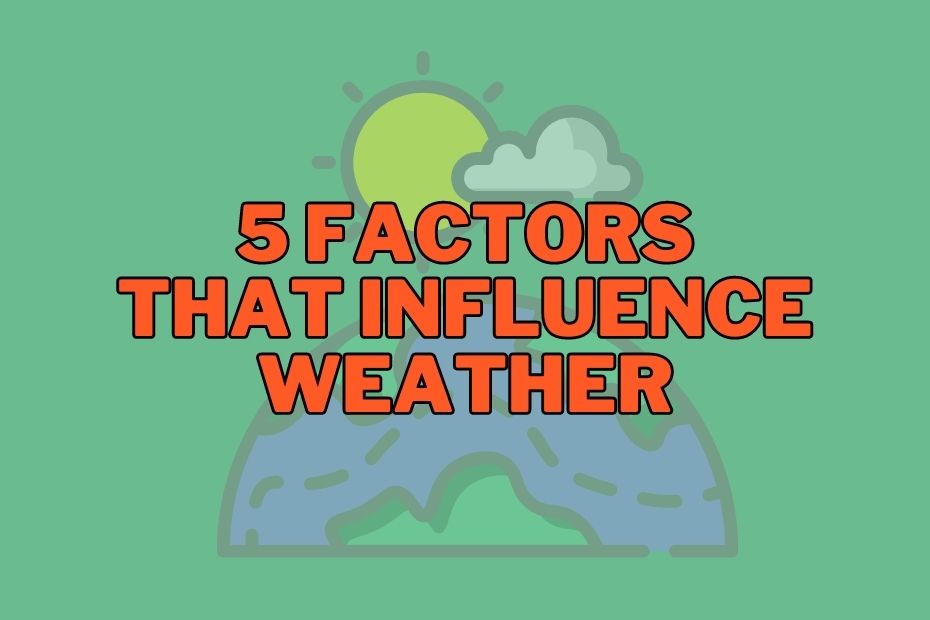Have you ever wondered why some days are sunny and others are cloudy? Or why some days are hot while others are cold? The answer lies in the 5 factors that influence weather. In this article, we will explore these factors in detail and how they impact the weather.
The 5 factors that influence weather are temperature, air pressure, humidity, cloud and wind speed.
The 5 Factors That Influence Weather
Weather is the state of the atmosphere at a specific time and place. It can vary widely depending on location, season, and time of day. But what causes these variations? Several factors influence the weather, and understanding them can help us predict and prepare for different weather conditions.
1. Temperature
Temperature is the measure of the amount of heat in the air. Warm air rises, and cold air sinks. Temperature variations can create differences in air pressure, which can cause wind.
Additionally, temperature can affect the amount of moisture in the air, which can lead to the formation of clouds and precipitation.
When warm air rises, it cools, and its moisture condenses, leading to the formation of clouds and precipitation. Conversely, when cool air sinks, it warms up and can hold more moisture, leading to clear skies.
2. Air Pressure
Air pressure is the force exerted by the weight of the air above us. The weight of the air decreases as we move higher in the atmosphere.
Low pressure occurs when the weight of the air is less than the surrounding air, while high pressure occurs when the weight of the air is more than the surrounding air.
Air pressure varies depending on altitude, temperature, and humidity.
When air pressure is high, it typically indicates fair weather, while low air pressure often indicates the potential for storms and precipitation.
3. Humidity
Humidity is the amount of moisture in the air. Warm air can hold more moisture than cold air. When warm, moist air rises and cools, the moisture can condense and form clouds. If the conditions are right, precipitation can occur.
Relative humidity is a measure of how much moisture the air can hold relative to its temperature. High relative humidity often makes it feel hotter than it actually is, while low relative humidity can make it feel cooler.
4. Cloud Formation
Cloud formation is influenced by several factors, including temperature, humidity, and air pressure. Warm, moist air rises and cools, which can cause the moisture to condense and form clouds. The amount of moisture in the air and the speed and direction of the wind can also affect cloud formation.
If the conditions are right, precipitation can occur, leading to rain or snow. Understanding the factors that influence cloud formation is crucial for predicting changes in the weather and issuing warnings for extreme weather conditions.
By monitoring temperature, humidity, air pressure, and wind, meteorologists can make more accurate weather forecasts and help keep people safe.
5. Wind
Wind is the movement of air from high pressure to low pressure. The speed and direction of the wind can impact the weather. It is caused by differences in atmospheric pressure and temperature. Wind plays a crucial role in shaping weather patterns, from gentle breezes to powerful storms.
Winds can also transport heat and moisture from one location to another, influencing weather conditions in different areas. For example, if the wind is blowing from a cold area, it can bring cooler temperatures, while if it is blowing from a warm area, it can bring warmer temperatures.
Conclusion
Weather is a complex and constantly changing phenomenon. By understanding the 5 factors that influence weather, we can better understand why the weather is the way it is and predict changes in the weather. Paying attention to these factors can help us prepare for extreme weather conditions and make informed decisions about our daily activities.
READ MORE: 7 Factors That Influence Climate Change
FAQs: 5 Factors That Influence Weather
How do air pressure and temperature affect weather?
Air pressure and temperature can affect weather by creating differences in air pressure, which can cause wind, and affecting the amount of moisture in the air, which can lead to the formation of clouds and precipitation.
Can wind impact the weather?
Yes, the speed and direction of wind can impact the weather. Wind blowing from a cold area can bring cooler temperatures, while wind blowing from a warm area can bring warmer temperatures.
How do meteorologists use the five factors that influence weather?
Meteorologists use the five factors that influence weather to make more accurate weather forecasts. By monitoring changes in air pressure, temperature, humidity, wind, and topography, they can predict changes in the weather and issue warnings for extreme weather conditions.
What causes differences in atmospheric pressure?
Atmospheric pressure differences are caused by the uneven heating of the Earth’s surface by the sun.
